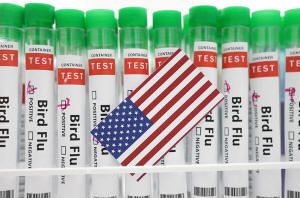More US bird flu spread would heighten human infection risk, officials
say
 Send a link to a friend
Send a link to a friend
 [June 14, 2024]
By Leah Douglas and Julie Steenhuysen [June 14, 2024]
By Leah Douglas and Julie Steenhuysen
(Reuters) -Further spread of bird flu among U.S. dairy herds presents
additional opportunities for human infections, federal officials said on
Thursday while urging farms to take enhanced biosecurity measures to
contain the virus.
Bird flu has been reported in 94 dairy herds across 12 states since late
March, according to the U.S. Department of Agriculture.
The risk to public health is currently low, though additional spread of
the virus could increase that risk, said Nirav Shah, principal deputy
director for the U.S. Centers for Disease Control and Prevention, on a
briefing call with reporters.
"The more infections there are among cows, the more risk there is for
infections to occur among humans," Shah said.
The CDC has monitored more than 500 people and tested at least 45 during
the current outbreak, Shah said.
Three dairy farm workers have tested positive since the virus began
circulating among dairy cows. The U.S. has advised farm workers to wear
protective gear to try to reduce their risk of exposure to the virus.
The U.S. and Europe are both preparing vaccines that could be used to
help protect farm workers this year.
A genetic analysis of the third human case found no signs of mutations
in the virus that would make it easier to transmit among people, Shah
said.
Asked whether the CDC should be testing people who have been exposed to
the virus but are not symptomatic, Shah said the agency is confident in
its current testing strategy.
Testing asymptomatic people could result in identifying people who are
carrying virus in their nose that would not actually cause an infection,
he said

[to top of second column]
|

Test tubes labelled "Bird Flu" and a piece of paper in the colours
of the U.S. national flag are seen in this picture illustration,
January 14, 2023. REUTERS/Dado Ruvic/File Photo
 The spread among dairy farms is
likely occurring from animal movement, shared personnel, and
vehicles and equipment that travel between farms, Kammy Johnson, a
veterinary epidemiologist with the USDA said on the call.
Wild birds, an early vector of the virus, do not appear to be
spreading the virus from herd to herd or to poultry farms, a USDA
report released on Thursday found.
Biosecurity practices like cleaning equipment and limiting movement
of sick animals are important to containing the spread of the virus,
Johnson said.
Asked how many farms with infected cows the USDA may be missing,
Johnson said: "That's the $64,000 question. We don't know what we
don't know."
The USDA is encouraging farmers to test their herds if they suspect
symptoms of the virus and is providing financial support for milk
and animal testing. Farmers from 11 of the 94 infected dairy herds
have signed up for those programs, said Mark Lyons, a USDA official.
Two dozen companies are currently in various stages of development
on an avian flu vaccine for cattle, Agriculture Secretary Tom
Vilsack told Reuters on Wednesday.
(Reporting by Leah Douglas in Washington and Julie Steenhuysen in
Chicago; Editing by Bill Berkrot)
[© 2024 Thomson Reuters. All rights reserved.]This material may not be published,
broadcast, rewritten or redistributed.
Thompson Reuters is solely responsible for this content. |